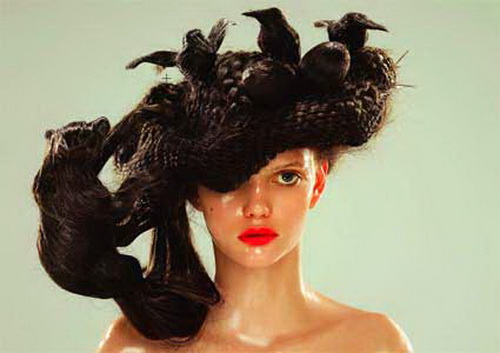
Hair
A Human History
Kurt Stenn
(Pegasus Books)

- We lose hair uniformly, losing from "fifty to one hundred scalp hairs falling out each day." That's everyone but me: I seem to run to ±1000 every week.
- When you are buried, if is it a dry location, your hair can "last for tens of thousands of years."
- However, if you are buried in a damp place like Louisiana, or under Niagara Falls, or in a rain forest, say good-bye to your hair. Why? Between 85 to 99 percent of dry hair shaft is protein: "Consider that the protein content of hamburger meat or a well-marbled stake ranges from 17 to 22 percent."
- Wigs were common in ancient Egypt for the royalty, not only for their heads, but for their chins. "Men, and occasionally women, wore long, cylindrical chin wigs at court as a mark of authority; these chin-wigs varied in presentation from straight to elegantly braided."
- During the 17th and 18th Centuries, people at the top of the European social scale wore the biggest hair-pieces. "In the extreme, an attractive wig would have incorporated into it model ships, bird cages, and flags."
- The "marcaroni" was a wig favored by young dandies in the same period, who often brought these treasures back from Italy. It was high in front, with a ribbon down the back . . . and denoted upper-class men who would look down their noses at you.
- To show their plebian stock, American youth merely stuck a feather in their cap "and called it macaroni, vide "Yankee Doodle."
- Merkins (hair pieces for the crotch) were popularized during the middle ages. "Prostitutes would shave their pubic hair in order to avoid lice, but then needed a cover for the marks of venereal diseases . . . "
- People still prefer human hair for wigs because of its natural look. Most wig stock --- plaits --- comes from South America and Asia.
- In Andhra Pradesh, India, "women donate their hair as a votive offering to Venkateswara, an incarnation of Vishnu who has the power to absolve sins." The temple then sells the hair --- "more than one ton per day."
- Selling locks of hair can be a profitable business. A book-dealer recently paid $119,500 for "a strand of black hair taken from the dead body of revolutionary leader Che Guevara."
- The hair on your head grows in a whorl --- "a vortexlike placement of hair at the top and back of the scalp."
- It runs either clockwise or counterclockwise. "More than 90 percent of right-handed people have a clockwise whorl."
- "Subjects with a clockwise hair-whorl orientation have a strong association with left brain language dominance," and
- "children with multiple or intersection whorls show a higher probability of having underlying brain malformations."
These are just the beginnings of the facts about hair that appear in Hair. We discover why professional "hatters" often went mad: it was the mercury used to make beaver hats. We learn how to shear a sheep: stand it on its hind legs, facing away from you; work from the top of the head down. We find out about hair shirts --- those coarse hairs from sheep that can be very itchy and prickly. They were worn by priests under their clothing, were "a constant reminder of their sins and worldly temptations." We learn that the best violin bows are made from the hair of Mongolian stallions, and that wool brought so much prosperity to Renaissance England that --- still --- there is a sack of wool in chair in a place of honor in the House of Lords.
In my dotage, I find that my eyebrows grow a constant 8 inches a week, and recall a tired joke from my youth was how we could just let our eyebrow hairs go wild then brush them back over our bald pates.
Hair transplants work because our hair grows at different speeds at different parts of our bodies, and the follicles can be moved from one area --- the side of the head, for instance --- to the top.
Speaking of such, the mechanics of your common follicle is so complicated that even, though, Stenn's writing is crystal clear, he lost me amongst all the epithelial cells, root sheaths, exogen cycles, and Mesenchymal cells --- which make "proteinaceous matrix materials such as collagen, cartilage, and bone."
Not to worry. It's a fun book, the author seems to know every thing you could ever want to know about your queue (if you choose to sprout one) and why barber poles are red and white. There were only three questions I had after (reluctantly) arriving at the end of this fascinating volume.
- Why do our normally sane, civilized and liberated women friends still shave their legs?
- Why is one of the most commonly used insult words in Latino countries "pubic hair?" (Sitting in the great Chapultepec Park in Mexico City, I eavesdropped on two rather regal ladies, talking about one of their friends, calling her "una pendeja." Have they no couth?)
- What are these otherwise well-mannered kids nowadays talking about when they refer, constantly, to the "hair pie."